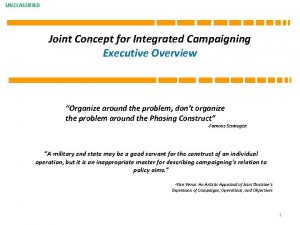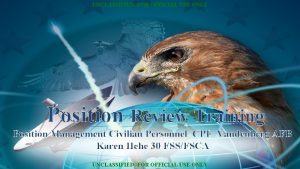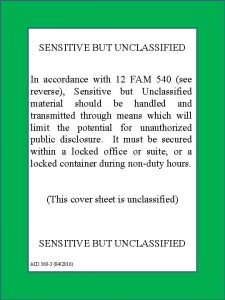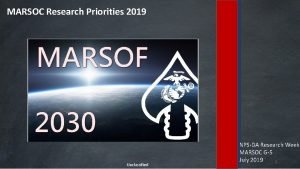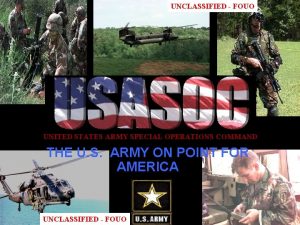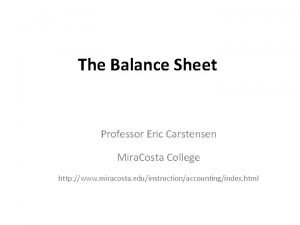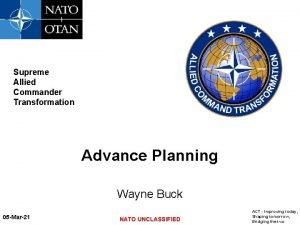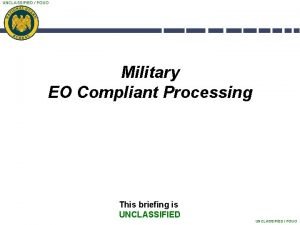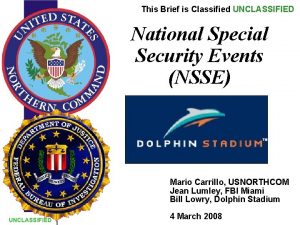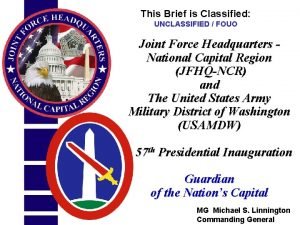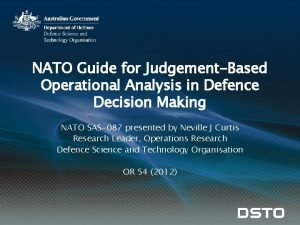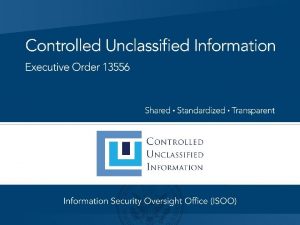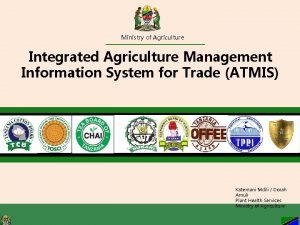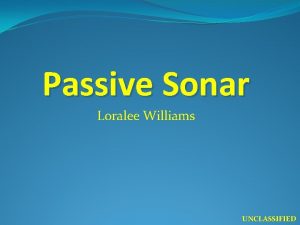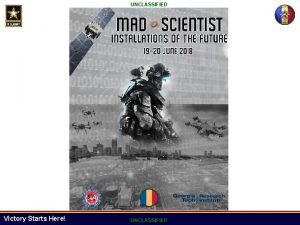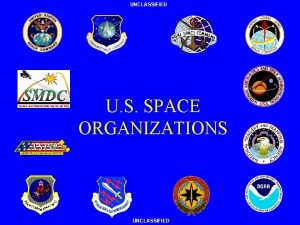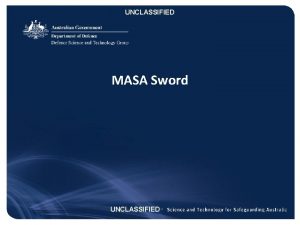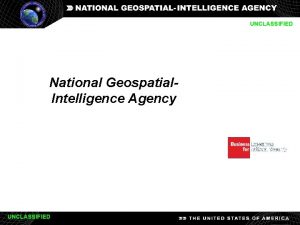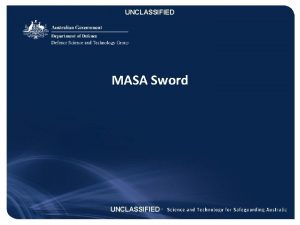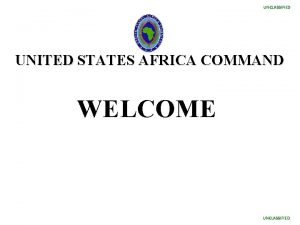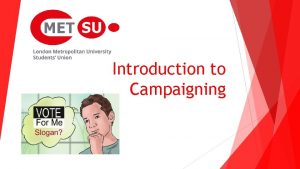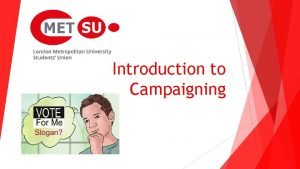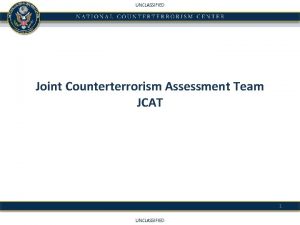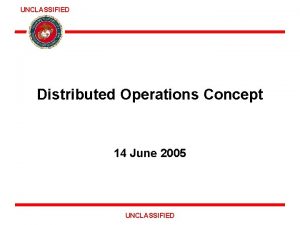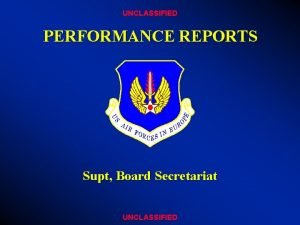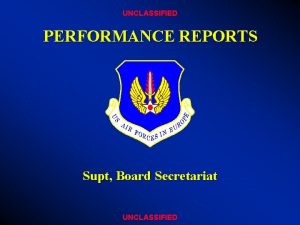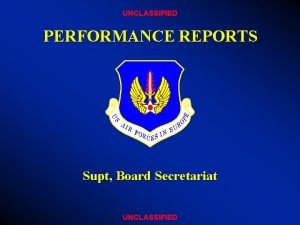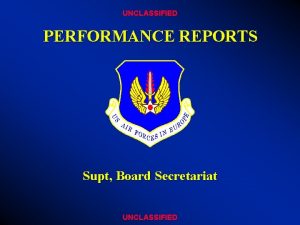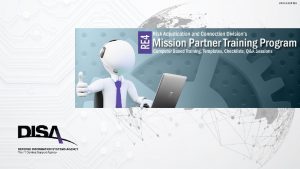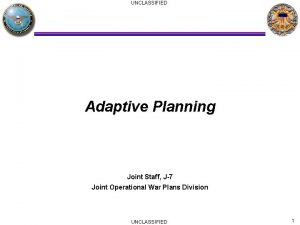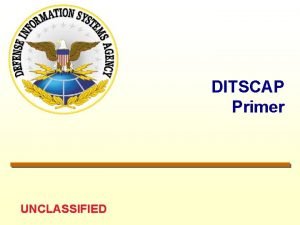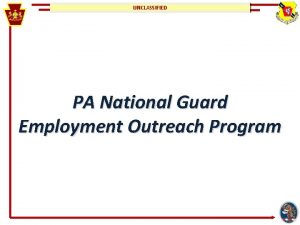UNCLASSIFIED Joint Concept for Integrated Campaigning Executive Overview




























































- Slides: 60

UNCLASSIFIED Joint Concept for Integrated Campaigning Executive Overview “Organize around the problem, don’t organize the problem around the Phasing Construct” -Famous Strategist “A military end state may be a good servant for the construct of an individual operation, but it is an inappropriate master for describing campaigning’s relation to policy aims. ” -Vice Versa: An Artistic Appraisal of Joint Doctrine’s Expression of Campaigns, Operations, and Objectives 1

We traditionally see ourselves at either peace or war, with war being an undesirable exception. War/Conflict “The Campaigning Effort” Peace In response, we’re pre-disposed to seek a rapid, conclusive “end” and return to normalcy – even though that is not our historical experience. At times, the Do. D exhibits an incomplete understanding of war/conflict (Ex. our “first battles”). Moreover, we’ve created and maintained a framework to our liking - in the manner of an ideal of how we would prefer conflict to unfold, but not one reflecting reality. Within the defense community, this has led to a narrow and inelastic interpretation of operational art and a flawed philosophy and model of campaigning. Doctrine does not 2 have a deep appreciation for the competition occurring on either side of armed conflict.

Model of the Universe of Competitive Int’l Relations and Differing Styles of Warfare How can we leverage new concepts to prevail short of armed conflict, advance/maintain security environments, and prepare for and follow through with future armed conflict? Unconventional Measures/WF Diplomatic/Econ Pressure Traditional / Conventional Warfare Irregular Warfare Do we have adequate theories, concepts, tools, practices, and components of design to campaign effectively across the entire spectrum of conflict and competition? 3

UNCLASSIFIED Current, Ongoing, and Future Challenges Securing Gains Translating military success into outcomes. Consolidating gains is an inherent part of armed conflict as well as a key aspect of effective campaigning to enable/achieve policy aims. “ Not some phase slapped on to the end. ” Countering Coercive Gradualism Strategic rivals are employing methods to accomplish objectives in the competitive space between peace and war…typically by remaining below policy makers thresholds for military response The future security environment can be described by two distinct but related sets of recent and emerging challenges: • Revisionist state and non-state actors will contest norms with creative strategies below the threshold of a U. S. military response • Persistent disorder may be the norm as instability is spread by weak states incapable of maintaining domestic order or good governance • Rivals will influence using ambiguity and exploit vulnerabilities in Do. D processes • Wars involving at least one non-state actor will remain common and crises may evolve rapidly 4 4

UNCLASSIFIED Is the legacy “Notional Plan Phasing Construct “ the tool that seeks to account for that universe? Peace Whether we meant it to be or not, this Illustration, the legacy description of the phases, and the elements of operational design have become a substitute campaign model across Do. D. The model and its predecessors are a symptom of trying institutionalize the ideals of the “Powell Doctrine” and everything Do. D liked about Just Cause and Desert Storm War/Conflict Peace This model has also become a subliminal “map” of Do. D’s capabilities and created artificial assumptions of under what circumstances we should employ those tools. Finally, this model and its associated description has blurred our understanding of the differences between campaigning and operations 5

UNCLASSIFIED Where/What were the beginnings? – 1992 National Mil Strat (NMS) Moved away from concepts of containment and guided the force toward organizing for regional conflict – stresses “swiftly”, “quickly”, & “rapidly” and decisively defeating an adversary. NMS 1992. Page 17. “Spectrum of Conventional Conflict” 6

UNCLASSIFIED Where/What were the beginnings? 1993 Bottom-Up Review (BUR) Both the NMS and BUR cognitive art/pictures represent force planning constructs- over time these ideas and mental maps migrated to become our default campaign/operational constructs Report on The Bottoms Up Review 1993. Fig. 6, P. 27 “Conflict Dynamics” 7

UNCLASSIFIED How did this model play out in reality? – 1993 BUR Conflict Dynamics - The directed activities within the notion of “peacetime” required almost as much as force as one MRC - The concept of “post-conflict” is a poor description of the inseparable circumstances of armed conflict 8 Report on The Bottoms Up Review 1993. Fig. 6, P. 27 “Conflict Dynamics” - Campaigning to translate military success into political outcomes requires a continuing effort & commitment

UNCLASSIFIED When do we ‘think’ we actually campaign? Peace War/Conflict Peace Phase 0 – Shaping JP 1, JP 3 -0, & JP 5 -0 describe CCMDRs’ actions in this space as “routine and normal activities” …the model suggests that either Do. D is either at peace or waging warfare – but accounts for very little in-between. JP 1. 0’s Chapter IV characterizes CCDRs’ duties in a narrow and binary fashion: “CCDRs are responsible for the development and production of joint plans and orders. During peacetime, they act to deter war through military engagement and security cooperation activities and prepare to execute other missions that may be required. During a conflict/combat, they plan and conduct campaigns and major operations to accomplish assigned missions. ” -JP 1. 0 9

UNCLASSIFIED The JCIC Framework JCIC’s framework is a function of seven discrete, but mutually supporting ideas. The confederation consists of: - Cooperation, Competition, and Armed Conflict - An alternative manner of organizing for problems and opportunities. A view of the environment characterizing the US relationship with another actor relative to a specific interest or grouping of interests. - An expanded definition of campaign/campaigning - A revised logic for follow through - campaigning throughout the consequences of armed conflict - securing gains and translating success into sustainable outcomes. - A logic and description for campaigning in competition below traditional armed conflict - An additive logic for campaigning in cooperation with allies/partners. - A lexicon beyond existing tactical and UJTL tasks to describe campaigning in cooperation, competition, and armed conflict - Factors of campaign design – a foundational array of considerations that expand beyond the existing elements of operational design. 10

The Logic and Framework of JCIC UNCLASSIFIED Logic #7 – Factors of Campaign Design Logic #1 – View of the OE Logic #2 Revised Definition of Campaigning Character of relations between the U. S. and an antagonist or protagonists L#6 – Revised logic for securing gains Logic #x – TMM/MDB* Logic #5 – A Lexicon/Terms for Competition L#4 – Logic for Competition Logic #3 – Additive Logic to the idea of Shaping/Cooperation Time; in years, maybe decades

UNCLASSIFIED Understanding the Environment: Expanded View of the OE • From a peace / war paradigm to three overlapping states of strategic reality: Ø Armed Conflict • Use of violence to satisfy interests or react to provocation ØCompetition Below Armed Conflict • Incompatible interests and the intention to engage in behavior detrimental to other strategic actor’s At times, we have had an appreciation for interests competition. It faded from strategic guidance between 1993 -1996. It was replaced by the intentions/hope of enlargement and inclusion ØCooperation • Mutually beneficial relationships between strategic actors with similar or compatible interests Supports an effective strategic dialogue with greater descriptive power to inform decision making up and guidance down 12

UNCLASSIFIED Campaigning Throughout the Consequences of Armed Conflict Securing gains and translating success into political outcomes 13 UNCLASSIFIED

UNCLASSIFIED Revised Logic for Securing Gains What do we tell ourselves we do after achieving military success? Peace War/Conflict Peace At times, Do. D sees this space as discretionary. Alternatively, history demonstrates that it’s a very demanding and essential part of the campaigning effort. At issue is - this is where we create conditions to achieve or enable desirable and sustainable outcomes. Assessing this space as “optional” doesn’t alleviate the risks resonant and posed by these conditions; nor that we won’t have to conduct missions required in this space. CCDRs consistently execute tasks normally associated with phases IV and V throughout Phase Zero. “Steady-State”? ? “Sustained Conflict”? Re-characterization 14 JP 5 -0, Joint Operational Planning

UNCLASSIFIED Thoughts on Termination and Military End State Peace War/Conflict Peace ? In previous versions our joint doctrinal prose, we said the military end state's conditions are used to define termination criteria; in another areas, we continue to say termination criteria defines the military end state – just the opposite. The 2017 versions further blur the distinction. Moreover, in our doctrine we continue to declare “JFC must know how POTUS/SECDEF intend to terminate the joint op…” upfront. Does that reflect reality? Regardless, analysis of our model suggests these two terms are fairly synonymous, but not centered on or tied to achieving a sustainable political outcome or reflect known patterns – more so on simply ending military operations. 15 JP 3 -0 page I-9, 10/III-2 and JP 5 -0 page IV-19, 20

An Incongruent Trinity UNCLASSIFIED The Relationship of Military End State, Termination, and Realizing the Aim Military End State ? Termination ? Realize the Aim* ? - There is an intellectual gap in how Do. D theorizes the translation of military success/advantage into sustainable outcomes. Where in the model would you plot Termination? , … Military End State? , … or the point at which we realize the aim or outcome of the policy? - We need to recognize that we have adopted a poor and ahistorical model to describe that translation, selected bad terms to define that translation, and characterized those terms with even worse descriptions. -Our current terms don’t account for a achieving a sustainable outcome in our philosophy of campaigning and joint campaign design methodology. 16 *Aim or Outcome is not a current element of Joint Operational Design

The Incongruent Trinity Plus+ One UNCLASSIFIED Military End State, Termination, Realizing the Aim, and “Post-conflict” Post-Conflict ? Realize Aim* ? Furthermore, where on the current construct would you plot the idea of “post-conflict”? Before, after, or on top of realizing the aim? Does the idea of “post-conflict” help or hinder our intellectual framework in orienting on outcomes? Do the ideas of Military End State and Termination help us develop successful campaigns? How about in conditions beyond armed conflict? Question: Are there adversarial approaches that avoid or are even immune to rapid, decisive operations? What are examples of relevant factors of design that would be useful in crafting campaigns to counter those styles of warfare? How would we describe translating military success in those conditions into outcomes? Again, do the terms we have help? ……. How should we begin to re-think our philosophy of 17 campaigning? *Aim or Outcome is not a current element of Joint Operational Design

UNCLASSIFIED How has the US effectively turned military victory into achievement of the aim and favorable, sustainable success? War/Conflict Success/Armistice Acceptable New and Enduring Bi-lateral Security Favorable partnership Commitment Migration Conditions Transition Situation Re-Characterization Of the Conflict X X X Perpetuation Advantageous Political Outcome “Prepared for what is next” Levels of Regional Competition & Social, Political, and Economic Upheaval Consolidation Perpetuation First of all, a sustainable outcome is the aim of campaigning, not simply the destruction of the adversaries’ war-making capability, or merely to attain a Military Endstate and then seek Termination. Successful US-led campaigning efforts account for the deep understanding required, amount of force needed, and time necessary to deliver/enable outcomes as we move beyond sustained conflict to navigating through the competition that follows, beginning with a re-characterization period marked by expanding political stakes that can confound our vision of the future; to creating favorable conditions; then to acceptable security situations; and later to a partnership and an enduring commitment to perpetuate our gains/realized advantage that prepares us for the circumstances that inevitably follow. Furthermore, successful campaigning seeks to consolidate gains as they materialize. Consolidation isn’t elective or discretionary, its required and perpetual. Joint leaders can’t wait for an imaginary time/space where conflict and risk are absent in order to consolidate. Finally, Joint Forces execute tasks from all phases, all the time throughout the 18 campaigning effort. Our current joint campaign construct does not articulate or account for the level of effort and time required to turn military victory into successful and sustainable outcomes.

Trend of U. S. Consolidation/Commitment Beyond Armed Conflict 1898 -2015 War on Terror 2002 15 13 Afghanistan 2001 1 Bosnia/Kosovo 1992 4 13 Haiti 1994 12 Somalia 1992 13 Iraq 1990 1 Panama 1989 1 4 Persian Gulf 1987 3 Grenada 1983 1 Honduras 1983 1 6 Sinai 1982 Lebanon 1982 1 1 El Salvador 1981 11 Columbia 1978 1 Dominican Republic 1965 2 Vietnam 1961 11 Lebanon 1958 1 Formosa 1950 5 Korea 1950 3 Japan 1941 4 Austria 1941 4 10 4 Italy 1941 Germany 1941 4 Nicaragua 1926 1 7 Panama 1918 2 Russia 1918 2 1 5 Rhineland 1917 Cuba 1917 6 8 Dominican Republic 1916 1 Haiti 1915 19 1 5 Mexico 1914 Nicaragua 1912 1 12 Panama 1903 11 1 China 1900 Phillipines 1899 3 11 13 Cuba 1898 0 Conflict Consolidation/Commitment 10 - Effective campaigning prepares the US for consequences of success and the circumstances that inevitably follow. Accomplishing just military objectives doesn’t necessarily lead to political aims or to the termination of military operations in support and sustainment of those policy goals. The aspect of finality is elusive. - Success requires a continued level of military effort beyond sustained conflict to consolidate gains in order to realize/enable the political outcome in the dynamic conditions following military success, and afterwards, perpetuate and sustain that outcome. - History shows that U. S. forces continue to operate long after the cessation of sustained armed conflict, sometimes for years or decades. Joint Force presence enables the other elements of national power. 25 33 32 62 70 70 70 * In many instances the conflict phase took only weeks or months to achieve - far less than the "1 year" annotation depicts. Often there was little or no major combat activity and consolidation activities began immediately. 40 20 30 40 Years 50 60 70 19 80 17 Aug 2015

UNCLASSIFIED Campaigning through Competition Reinforcing and Modifying Behaviors What can we learn from the past? 20 UNCLASSIFIED

Logic for Competition Are our potential adversaries’ approaches unfolding within a gap of our Joint Campaigning philosophy and construct? UNCLASSIFIED Chinese SCS Coercion Russian Aggression n. K Provocation Iranian Influence ? TCP GCP ? State and non-state adversarial approaches are accomplishing wartime-like objectives beyond the reach, authorization, and effectiveness of existing theater campaign efforts and US law, title, and code but far short of provoking the US toward seeking a legitimate Int’l community charter(such as an UNSCR or NATO Defense Treaty Article) or unilateral response. Our current philosophy of campaigning doesn’t recognize this nuance. An alternative model must enable the US to legitimately campaign in this space to actually counter and defeat adversary approaches characterized by episodic and continual confrontations of narrative, cyber intrusion, influence actions, and ambiguous force 21 JP 5 -0, Joint Operational Planning without sustained conflict

UNCLASSIFIED An Alternative Display of the same Intellectual Gap… War/Conflict Peace Armed Conflict Competition Chinese SCS Coercion Iranian Influence ? Russian Aggression n. K Provocation Cooperation State and non-state adversarial approaches are accomplishing wartime-like objectives beyond the reach, authorization, and effectiveness of existing theater campaign efforts and US law, title, and code but far short of provoking the US toward seeking a legitimate Int’l community charter(such as an UNSCR or NATO Defense Treaty Article) or unilateral response. Our current philosophy of campaigning doesn’t recognize this nuance. An alternative model must enable the US to legitimately campaign in this space to actually counter and defeat adversary approaches characterized by episodic and continual confrontations of narrative, cyber intrusion, influence actions, 22 and ambiguous force without sustained conflict

Modern Russian Approach UNCLASSIFIED Compared to Do. D’s JOPES Phasing Construct (Bins vs. Phases) Visible Invisible Bin #8 Bin #4 Destabilize thru propaganda to “Increase discontent, boosted by the arrival of “bands” of militaries, escalating subversion. ” Bin #3 Coercion & Undermining “Bribe, Intimidate, Deceive government and military officials” Bin #1 Roll over the remaining points of resistance and destroy surviving enemy units by special operations Bin #7 Combine targeted information, electronic warfare & aerospace ops continuous air force harassment, with the use of high-tech weapons Bin #6 Bin #2 Info/Diplomatic Deception “Confuse/Stymie/Mislead Adversary’s understanding and decision making” Bin #5 Commence military action w/ all types, forms, methods, and forces. Preceded by large scale recon and subversive missions. Establish of no-fly zones over the adversary’s country, impose blockades, Extensive use of private military companies in close cooperation with armed opposition units. In the context of employment, these groupings of activities seem more like bins of tool boxes or capabilities the Russians apply as “appropriate and necessary” as opposed to sequential and mechanical phases. 23 They have simultaneously “presented” all eight – either through employment or unambiguous signaling. Introduce Non-military asymmetric warfare capblts “To create a Favorable POL/MIL & economic setup”

UNCLASSIFIED Does the current campaign framework help us think through the military’s role and contribution in countering our potential adversaries’ modern styles of warfare? War/Conflict “The Campaign Effort” Peace Ex. The Russian “New Gen” Approach compared to how we prefer conflict to unfold What the Russians, Chinese, and others are willing to pursue against our and partners’ interests in the space that we want to consider “peacetime” is dramatic. Many nations, including our possible adversaries don’t have the same bi-furcated view that they are either at peace or war. They see their actions “…as a natural part of the ebb and flow of international relations “ ver 3 24

UNCLASSIFIED Are we seeing other similar approaches unfolding? War/Conflict Coercion, Provocation cycle, Mal-influence ISIL Peace “The Campaign Effort” Peace It’s not too hard to intellectually place the Chinese, n. K, ISIL, and Iranian unfolding activities in the same space. ver 3 25

UNCLASSIFIED Engagement Between Peace and War Force without War – What can we learn from the past? • In 1978, Barry Blechman and Stephen Kaplan published the results of landmark study titled, Force without War: U. S. Armed Forces as a Political Instrument. Their study chronicled analyzed over 200 cases occurring since World War II, where the US employed forces to reinforce or modify foreign actors’ behaviors. • Although several decades old, the study’s context and analysis may be worth considering as we think through how military institutions might adapt to the contemporary environment. • Highlights that the US has a rich history of confronting antagonists and engaging allies and partners in ambiguous and uncertain conditions less than armed conflict to achieve political objectives. • The study’s criteria for success was whether or not the specific actor(s) behaved in the manner desired by the policy’s aim. Blechman and Kaplan analyze thirty-three substantive cases to determine rates of realization of antagonists’ and protagonists’ desired behavior sought by the U. S. where the policy included a military dimension. • The study captures the trends and results in terms of percentages(%) positive outcomes for both the short term (6 months) and longer term (3 years). • Regarding the military dimension’s role in conditions beyond armed conflict, Blechman and Kaplan’s effort may offer insights as to future optimal and effective applications of force. 26

UNCLASSIFIED Blechman and Kaplan’s Force without War – What can we learn from the past? • Examines three general categories of the US’ discrete and purposeful use of force beyond armed conflict. • Counter an antagonists use or threatened use of force against an protagonist/neutral actor. • Contest an actor’s support to an antagonistic third party • Reinforce regime/state authority to exercise governance over its own territory. • In terms of the approach of the US’ commitment of force regarding an incident, the authors describe two primary modes. § First, the US force was seeking to reinforce existing behavior: • to deter the antagonist from behaving in a manner detrimental to US interests; • to assure potential protagonists so that they will continue or abstain from a behavior relative to US interests. § The second is to modify or change a direction of behavior: • to compel antagonists to either act in a manner or to stop behavior running counter to US interests. ; • to induce a potential protagonist to initiate beneficial or cease harmful actions. The study analyzes the US’ military experience and success rate in both direct and indirect involvement. • • Highlights circumstances of using force to alter behaviors in both interstate and intrastate conflicts. • Examines excursions in how the Soviet Union’s involvement in many of the cases alters the US’ attainment of positive outcomes. 27

UNCLASSIFIED Logic #4 - Force without War – What can we learn from the past? Force without War - With effective anticipation, we are successful in maintaining current behavior - Not as successful in changing/modifying behavior once an actor embarks upon a certain policy shift, or initiates action Figure 1. Overview of US’ Success in Affecting Behavior Short of Armed Conflict. 28 UNCLASSIFIED

UNCLASSIFIED Applications of Force Without War Force without War – What can we learn from the past? “Of the three principle categories of objectives, positive outcomes were most frequent when armed forces were aimed at objectives related to regime/state authority, less frequent when they were aimed at the use of force by another actor, and least frequent when they were aimed at an actor supporting a third party. ” 29 (Blechman and Kaplan)

Patterns and Factors of US’ Successful and Unsuccessful Uses of Force-w/out. Applications of Force Without War Positive Outcomes were proportionally higher when the US had: - A clear and easily interpreted narrative led the commitment of force - A treaty existed that was supportive of an outcome relative to the incident. - Previous/Demonstrated willingness to engage in armed conflict/war in that region - The force engaged in recognizable activities germane to the circumstance - Armed forces were used to reinforce existing behavior before change occurred Positive Outcomes were proportionally lower when the US: - Did not have a relevant presence in the region before the circumstance. - A poor diagnosis of an antagonist’s behavior drove the purpose - Mis-interpreted a protagonist’s propensity to act in friendly interests - A statement or narrative merely followed the commitment of force - Failed to effectively consolidate success; success has a short half life 30

UNCLASSIFIED Logic for Campaigning in Competition -Campaign design should account for both maintaining and modifying behaviors. In general, successful campaigning through competition requires success across all four of the Blechman-type circumstances, and probably more. -Many of the current antagonistic approaches are nuanced and limited, but may not be necessarily exercised through proxies. As these issues are matter of great powers in direct competition, the campaign design should consider and account for the entire range antagonists, protagonists, neutral parties, as well as the transregional nature of behaviors. Actors’ Behaviors Assure Reinforce Existing Behavior Deter Induce Modify Behavior Organized around contested issues and employed together, the traditional concepts of assure, deter, induce, and compel are “bins” of tailored and matched national capabilities levied against specific aspects of the problem set. Compel 31

UNCLASSIFIED Logic for Campaigning in Competition JCIC’s logic for campaigning in competition describes organizing around specific problems and contested interest(s) by employing combinations of activities and measures toward multiple instances of desired behaviors…. . success requires the effective blending of informational, diplomatic, and military power. Employ Informed Combinations Of Activities & Measures Reinforce Existing Behaviors Modify Behaviors Assure Induce The campaign design may have to account for multiple instances of mission areas, each with their own peculiarities and requirements Deter Compel 32 MIN

UNCLASSIFIED Logic for Campaigning in Competition JCIC’s logic for campaigning in competition describes organizing around specific problems and contested interest(s) by employing combinations of activities and measures toward multiple instances of desired behaviors. Success requires the effective blending of informational, diplomatic, and military power. Each “bin” can consist of a tailored and matched mix of national capabilities levied against a specific aspect of the problem set(s) Sample A Compel “Mix” Narrative/Informt’l Diplomatic Pressure Unconventional Meas Economic Measures Latent, Indirect, Uncvn & Direct use of Force Styles of the Use of Force - w/o War - Latent - Indirect - Unconventional 33 - Direct

UNCLASSIFIED Logic for Campaigning in Competition JCIC’s logic for campaigning in competition describes organizing around specific problems and contested interest(s) by employing combinations activities and measures toward multiple instances of desired behaviors. Success requires the effective blending of informational, diplomatic, and military power…to contest, contain, counter, improve, or even deconstruct the antagonistic behavior and circumstances – based on policy intentions. Requires the attributes and principles of Global Integration CCMD Assure Apply Informed Combinations Of Activities & Measures through and across multiple CCMDs Deter Assure Deter CCMD Induce Compel Induce CCMD Compel 34

UNCLASSIFIED Logic for Campaigning in Competition JCIC’s logic for campaigning in competition describes organizing around specific problems and contested interest(s) by employing combinations activities and measures toward multiple instances of desired behaviors. Success requires the effective blending of informational, diplomatic, and military power…to contest, contain, counter, improve, or even deconstruct the antagonistic behavior and circumstances – based on policy intentions. Range of Policy Intentions toward Actors’ Behaviors MAX Deconstruct Improve Counter Contain The campaign artists’ design must be in the context of a flexible and adaptable range of political ambitions/intentions, not finite “end states” Contest 35 MIN

UNCLASSIFIED Logic for Campaigning in Competition JCIC’s logic for campaigning in competition describes organizing around specific problems and contested interest(s) by employing combinations activities and measures toward multiple instances of desired behaviors. Success requires the effective blending of informational, diplomatic, and military power…to contest, contain, counter, improve, or even deconstruct the antagonistic behavior and circumstances – based on policy intentions. Range of Policy Intentions toward Actors’ Behaviors MAX Deconstruct JCIC Competition Mechanisms -In addition to the Blechman Study examples. Strengthen. To develop alliances and partnerships and reward actors for siding with friendly forces. Create. To produce a condition where it does not already exist, and its existence could positively impact achievement of national interests or may be essential. Preserve. To prevent deterioration of a stable situation. Although, there is no assumption of immediate malign intent by other actors, if ignored this condition could lead to the rise of an adversary. Weaken. To recognize, understand, and impose a change in a competitor’s behavior using physical & informational aspects of power. Position. To increase access, influence, and strategic understanding in the environment. Inform. To develop a shared perspective with partners and identify areas where cooperation would be of mutual benefit Persuade. To shape partners’ objectives and competitor behaviors while remaining flexible in the pursuit of secondary objectives. Improve Counter Contain Campaign artists recognize they must work toward flexible policy ambitions that change in accord with a fluid strategic environment; attempting to adhere to fixed "military end states" is likely to produce a rigid mindset that is unresponsive to policy Contest 36 MIN

Either Succeeding & Consolidating Progress or Failing & Adapting to setbacks Actors can win or lose in competition regarding a specific interest without resorting to Armed Conflict or establishing and imposing a new Cooperative Homeostasis. Designated Enemy Character of relations between the U. S. and an antagonist or protagonist Adversarial Competitive or Antagonistic Cooperative or Protagonistic Time; in years, maybe decades UNCLASSIFIED

UNCLASSIFIED Competition Mechanisms within the Alternative View of the OE Logic and relevant terms for campaigning in competition against antagonistic behaviors Designated Enemy Character of relations between the U. S. and an antagonist or protagonist Levels of Intentions Combinations Of Activities & Measures -Deconstruct Adversarial In a state of continual ebb and flow where the Joint Force should have a logic to campaign to advance/protect a specific or grouping of interests -Improve -Counter -Contain -Contest Competitive or Antagonistic Cooperative or Protagonistic Time; in years, maybe decades UNCLASSIFIED

UNCLASSIFIED Campaigning through Cooperation In Pursuit of Mutually Beneficial Interests and Conditions 39 UNCLASSIFIED

UNCLASSIFIED What are the Joint Forces’ capabilities and range of activities within in theater campaign’s current description? Public Affairs Civil Affairs Coop w/ NGOs HA/DR SSA FID FMO NEO MIL Engagement MN Exercises MISO IO Precision Strike Missile Defense UW IAD Detect Threat Networks R&S CT 1206 MIL Deception COIN/SFA Counter WMD Intel Sharing Personnel Recovery Raids EW ISR Strategic Deploy What do our bins of capabilities look like? What should the bins look like? Are these “tools” really integrated or synchronized within a coherent model for campaigning beyond traditional armed conflict? Are these just functional activities employed wherever they can be “squeezed in”, toward loosely or ill-defined objectives? Can we organize, authorize, and arrange these capabilities to counter the adversaries approaches we see currently unfolding? 40

UNCLASSIFIED How has previous doctrine tried to define shaping? Military Operations Other Than War focus on deterring war, resolving conflict, promoting peace, and supporting civil authorities in response to domestic crises; Use of military forces in peacetime helps keep the day-to-day tensions between nations below the threshold of armed conflict or war and maintains US influence in foreign lands. - JP 3 -07 Joint Doctrine for Military Operations Other Than War (16 June 1995) Military participation in security cooperation activities to support fragile states, avert crisis, or prepare for future operations; Activities in the shaping phase primarily focus on continued planning and preparation for anticipated stability operations in the subsequent phases. -JP 3 -07 Stability Operations (29 December 2011) Peace operations are conducted in a dynamic environment shaped by a number of factors and variables that strongly influence the manner in which operations can be conducted. Successful commanders grasp the importance of these variables. The critical variables of peace operations are The level of consent, the level of force, and the degree of impartiality. - FM 100 -23 Peace Operations (December 1994) The national security and national military strategies establish an imperative for engagement. The US will remain politically and militarily engaged in the world and will maintain military superiority over potential adversaries. Engagement elevates to mission status the role of the US armed forces in shaping an international environment that promotes and protects US national security interests, before threat of conflict arises. Forward basing, forward presence, and force projection enhance the ability of Army forces to engage other nations—their people, governments, and militaries - FM 3 -0 Operations (June 2001) Historically, we have focused on indirectly describing some components of shaping. Absent from doctrine is a comprehensive way to think about how operations other than war fit in the larger specific strategic objective and the overall campaign plan —we just say that it is important.

UNCLASSIFIED How do we currently attempt to define ‘shaping’? Current Joint Publications • Military Engagement, Security Cooperation, and Deterrence. These ongoing activities establish, shape, maintain, and refine relations with other nations. • Security cooperation is a key element of global and theater shaping operations. • A TCP is based on planning guidance provided by the GEF and JSCP. A TCP operationalizes CCDR functional and theater strategies. Campaign plans focus on the command’s steady-state (Phase 0) activities, which include ongoing operations, security cooperation, and other shaping or preventive activities for the next 5 years. - JP 1 Doctrine for the Armed Forces of the United States (25 May 2013) • Steady-state operations and activities, which encompass shaping activities (including shaping elements of contingency plans)… (JP 5 -0 pg. II-22) • Developing the Operational Approach…What will be the likely consequences as we seek to shape the operational environment toward a desired set of conditions? (JP 5 -0 pg. III-14) • Stability Mechanisms…Combinations of stability mechanisms produce complementary and reinforcing effects that help to shape the human dimension of the operational environment more effectively and efficiently than a single mechanism applied in isolation. Stability mechanisms may include compel, control, influence, and support. (JP 5 -0 pg. III-30) • Ensure success by shaping perceptions and influencing the behavior of both adversaries and partner nations, developing partner nation and friendly military capabilities for self-defense and multinational operations, improving information exchange and intelligence sharing, and providing US forces with peacetime and contingency access. - JP 5 -0 Joint Operation Planning (11 December 2011) • Shape phase missions, task, and actions are those that are designed to dissuade or deter adversaries and assure friends, as well as set conditions for the contingency plan and are generally conducted through security cooperation activities. Joint and multinational operations and various interagency activities occur routinely during the shape phase. • Since the focus of the shape phase is on prevention and preparation, any stability operations in the JFC’s proposed operational area might continue, and combat (offense and defense) may be limited or absent. • Considerations for Shaping: JFCs are able to assist in determining the shape and character of potential future operations before committing forces…enhance bonds between potential multinational partners, increase understanding of the region, help ensure access when required, strengthen future multinational operations. and prevent crises from developing. - JP 3 -0 Joint Operations (11 December 2011) Our current doctrine focuses on what types of activities are included under ‘shaping’. The definitions largely refer to themselves. The closest doctrinal discussion of operational approach occurs in JP 5 -0, which describes a desired set of conditions.

Beyond Shaping: An Alternative Description and Framework • Currently, Do. D describes activities in conditions less than conflict as Shaping and Deterring. Additionally, Do. D has a broad array of tools and methods to employ. However, we don’t really have a description or model or coherent logic that really helps the joint community think through designing efforts whereby “shaping” through military actions/activities is synonymous with the idea of campaigning and therefore links and leads to desirable conditions or outcomes. • A current joint theory of shaping doesn’t exist and the doctrine’s description is open to broad interpretation. Furthermore, we don’t have a joint organizing framework to plan and execute the concept of “Shaping. ” On the other hand, each service, joint, and OSD communities have published volumes on cooperation, just not in the context of campaigning – namely because its not armed conflict. Therefore, we initially proposed five DRAFT distinguishable aspects of campaigning in cooperation – beyond just actions within a theater of war, to realize favorable conditions in the context of pursuing strategic guidance and US interests. These were: • Advance • Create • Change • Maintain • Restore A Condition These aspects underpin and characterize proactive, competitive methods and measures within our revised philosophy to promote favorable conditions.

UNCLASSIFIED Initial Campaigning Construct for Cooperation The Differing/Range of conditions the joint force seeks to realize when campaigning in cooperation with allies and partners Advance There is some level of existing condition that aligns w/ our interests, but not at the level which meets our OBJ or purpose. Examples: Maintain The desired condition exists, and we want to neither degrade to increase significantly, where increasing would risk changing the condition unfavorably. In contrast to ‘Restore’, no large shock has occurred to disrupt this condition. • NATO structure and military capabilities exist, but we wish to increase readiness and capabilities of member state contributions in order to meet an objective of deterrence • NATO member states’ defense budgets already exist, but we desire for them to meet 2% GDP minimum goal. Examples: • Sustainment and medical infrastructure and US military posture in Europe are satisfactory – where return of entire Cold War land force levels might have negative impact on partner, domestic, or adversary behavior • ROK-US and Japan-US bilateral defense treaties remain supported by hostnation representative government. Insisting that either ROK or Japan govt’s alter their bilateral treaties with the US to such an extent that they become trilateral mutual defense treaty (ROK-Japan-US) may have negative impacts on status quo behavior of either govt. towards their US bilateral treaties. Change The existing condition is not malignant nor counter to U. S. interests, but it has the potential to positively align w/ U. S. OBJs. There is no assumption of malign intent. Create The condition does not exist, and its existence could positively impact achievement of national interests. Examples: • Non-aligned state (e. g. India during Cold War) has the military capability to withstand Soviet coercion • Countries along northern distribution route to Afghanistan tolerate delivery of cargo through their territory, based on agreed caveats, but their governments do not actively align their foreign policy with coalition objectives. • Establishing NATO alliance in the aftermath of WWII • Bilateral defense treaties between US-ROK, USJapan - • Formal coalitions (KFOR, ISAF, SFOR) • Building dual-purpose host -nation infrastructure (e. g. C -17 capable airfields, deephull capable port facilities) • Training professional security forces where none existed before Restore Some condition that was aligned w/ US interests existed, but a shock (e. g. natural disaster, conflict) happened to significantly alter it. It is w/in US interest to return to some state that resembles the condition before the shock. Examples: • Marshall Plan, Tsunami assistance, Pakistan earthquake assistance all work to restore the economic and infrastructure viability of the recipient states to a level approaching their pre-shock level • Post-war (Civil War, WWII) transition from occupation to reconciliation to full restoration of relations between populations. • Partner nations are willing to contribute forces and resources within the established coalition structure 44

UNCLASSIFIED Campaigning Construct for Cooperation (1 of 5) The Differing/Range of conditions the joint force seeks to realize when campaigning in cooperation with allies and partners Selective 45

Campaigning Construct for Cooperation (2 of 5) UNCLASSIFIED Exercising Relationships Understanding The Character of Relationships Control Coerce This involves direct influence over actor(s) who would normally be aligned counter to our desired condition/behavior. Like ‘control’, this is normally applied to those actor(s) who would align counter to our desired condition/behavior. While it may not involve direct influence as with ‘control’, it implies that we have the means and the will to apply that level of influence if necessary. Examples: • U. S. military occupation of defeated territory and populations at the end of the Civil War and World Wars I and II Examples: • U. S. occupation of • Military Haiti 1915 • Operation Just Cause in Panama 1989 Cooperative When an actor(s) is not clearly supportive nor counter to our overall interests or objectives, but may have a specific interest which aligns with ours, we may choose to co-opt that actor. Examples: • Local power- mobilization combined with maritime interdiction during the Cuban Missile Crisis brokers seek to move their products to market on the same main supply route as our forces, and desire to avoid attacks on the infrastructure that allow goods to flow. • Operation Uphold • Supplying the Democracy in Haiti (1994 -95) • Sailing an aircraft carrier through the Strait of Taiwan forces of the Soviet Union in our aligned interest of defeating Nazi Germany. Broaden Reinforce Inspire Establish When we have an established relationship with an actor, but realize that we must further our relationship without coercion to achieve our desired condition/behavior. In other words, we must strengthen the good terms of our relationship. At times, independent actor(s) may already have taken action , of their own accord, that aligns with our interests. In these cases, we seek to support their actions, and do not necessarily need to take the lead (though that may change with continual assessment). In contrast to ‘reinforce’, in this case potential actor(s) have not yet taken action, but there is potential that they could be inspired to initiate action that would be aligned with our interests. We realize that we do not have a relevant relationship with an actor and must establish a germane relationship with them. Examples: • Sale of and training on M 1 tanks to the Kingdom of Saudi Arabia Examples: • Saber Junction Britain with Lend Lease during their struggle with Nazi Germany before U. S. entry in 1941 • Providing logistical and sustainment support to French forces in Mali • Sending trainers to advise and assist the Ukrainian national guard in 2015. exercises to promote interoperability between NATO military members • French in Mali. • Supporting Great Examples: • The Allies training and deploying expatriates as resistance fighters within occupied Europe in WWII Examples: • Commodore Perry establishing relations with the Japanese 18531854. • Operations with the Afghan Northern Alliance in 2001. 46

UNCLASSIFIED Campaigning Construct for Cooperation (3 of 5) State of Partners’ National Power & Propensities to Align with our Interests Contested Fragile System/Power base is weak and under duress from both internal and external opposing sources of power System/Power base is functional, but weak and threatened by internal and external influences Interests: • Near-term survival • Willing to accept outside assistance Interests: • Establishing and maintaining stability to consolidate power and authority Kleptocracy /Clientelism In Transition System and Power is established either by extortion of the country’s resources and GDP or by paying of key sectors of the population. Maintained by internal security institutions, masked legitimacy, and fear. On occasion, established systems are incentivized to change. This can be from state controlled economies to market economies, from representative and pluralistic govt’s to autocratic systems. Interests: • Control of • Balancing populations • Resistant to outside influence continuity and change; established and accepted norms with introducing progressive reforms Maintaining Stasis System is durable and evolving & advancing slowly. Credible & effective institutions Interests: • Clear identity • Focused on maintaining status quo • Perception of Legitimacy • Maintaining Relationships • Conservative Regional engagement Growing/ Expanding Signified by established systems of governance, education, and justice. Mature institutions that can accumulate economic, diplomatic, informational power Interests: • Increasing International Trade/broadening markets • Joining Alliances • Limited Foreign Policy objectives Pursuing External Interests Mature systems with broad and resilient elements of national power and competitive/ comparable advantages Interest: • Employ their advantages internationally and reap the benefits. • Moderate to aggressive foreign policy objectives to further advance and protect their advantages. 47

UNCLASSIFIED Campaigning Construct for Cooperation (4 of 5) Do. D Security Cooperation Focus Areas (In revision, but by and large these functions continue under different names) The portfolio of authorities and lines of funding are always evolving. By itself, describes unique efforts but was is a poor guide to campaigning in cooperation • • • Capacity building Operational capacity and capability building Human capacity and/or human capital development Institutional capacity and/or security sector reform Support to institutional capacity and/or civil-sector capacity building Combined operations capacity, interoperability, and standardization Facilitating access and relationships Operational Access and Global Freedom of Action (U. S. Defense Posture) Intelligence and information sharing Assurance and regional confidence building International armaments cooperation International suasion and collaboration 48

UNCLASSIFIED Campaigning Construct for Cooperation (5 of 5) A deep understanding of all six of these aspects leads to good choices and realistic expectations. “Always Evolving” State of Relationships Partners’ Propensity Issue & Consequences Required Conditions 49

UNCLASSIFIED Campaigning Construct for Cooperation (5 of 5) A deep understanding of all six of these aspects leads to good choices and realistic expectations. USG Inter-agency relationships - Varying Interests - Their Objectives - Priorities “Always Evolving” State of Relationships Partners’ Propensity Issue & Consequences Required Conditions 50

UNCLASSIFIED Campaigning Construct for Cooperation (5 of 5) A deep understanding of all six of these aspects leads to good choices and realistic expectations. USG Inter-agency relationships - Varying Interests - Their Objectives - Priorities “Always Evolving” State of Relationships Partners’ Propensity Issue & Consequences Required Conditions US Foreign Assistance ($33. 9 B FY 2017) Current and Imminent Lines of Funding - Over 100 Countries 20 Different USG Agencies Global Peace, Security, Development 9 x major categories, 52 Sectors http: //beta. foreignassistance. gov/ 51

UNCLASSIFIED Campaigning Construct for Cooperation (5 of 5) A deep understanding of all six of these aspects leads to good choices and realistic expectations. USG Inter-agency relationships - Varying Interests - Their Objectives - Priorities “Always Evolving” State of Relationships Partners’ Propensity US Foreign Assistance ($33. 9 B FY 2017) Current and Imminent Lines of Funding - Over 100 Countries 20 Different USG Agencies Global Peace, Security, Development 9 x major categories, 52 Sectors http: //beta. foreignassistance. gov/ Issue & Consequences Required Conditions The Joint Force can conduct detailed /relevant “interest mapping” Identify and align common interests and facilitate efforts toward creating the necessary conditions, minimize wasted effort, reduce risk of alienating a partner from their power base, and avoid actions that run counter to our’s /partners’ long-term interests. - Additionally, this helps the Joint Force empathize with a partner, understand their calculus, and vision of the future. - Aids in estimating the range of possible futures – both good and bad. 52

UNCLASSIFIED Alternative View of the Contemporary Environment Levels of intentions or ambitions for campaigning to pursue mutually beneficial interests Designated Enemy Character of relations between the U. S. and an antagonist or protagonist Adversarial Levels of Intentions Competitive or Antagonistic A perpetual state or circumstance Where the Joint Force must “campaign” to advance/protect a specific or grouping of interests Cooperative or Protagonistic -Advance -Maintain -Sel Engagement Time; in years, maybe decades UNCLASSIFIED

Wrap up and Concluding Remarks UNCLASSIFIED The Logic and Framework of JCIC Logic #7 – Factors of Campaign Design Logic #1 – View of the OE Logic #2 Revised Definition of Campaigning Character of relations between the U. S. and an antagonist or protagonists L#6 – Revised logic for securing gains Logic #x – TMM/MDB* Logic #5 – A Lexicon/Terms for Competition L#4 – Logic for Competition Logic #3 – Additive Logic to the idea of Shaping/Cooperation Time; in years, maybe decades

UNCLASSIFIED Joint Concept for Integrated Campaigning Factors of Joint Campaign Design Coherent Arrangement – Putting it all together 55

UNCLASSIFIED Introduction to the Factors of Campaign Design Across JCIC’s competition continuum, there are common considerations to keep in mind when designing campaigns. Joint doctrine currently describes thirteen elements of operational design which collectively enable Joint leaders to design operations aimed at defeating adversaries’ war-making capability in armed conflict (JP 5 -0). These design elements are still valid for individual operations, but insufficient to enable Joint leaders to campaign in cooperation, competition, and armed conflict. The JCIC addresses this shortfall through the proposed use of the Factors of Campaign Design. The factors of campaign design connect with, respond to, and inform evolving policy. A campaign design factor is an element that influences or contributes to a particular result or outcome. These factors provide an additive array of thought to enable the Joint Force to campaign through the application of military force in concert with the other instruments of power. Collectively, they: - Guide the development and execution of campaigns across the competition continuum. - Aid design and understanding the relationship between civilian guidance and objectives - Facilitate collaboration with essential USG and international partners. - Improve the application of operational art beyond a narrow conception of armed conflict. - Provide an intellectual mooring, framework, and feedback loop between the strategic discussion and development and refinement of the operational-level logic and mechanism used to pursue the chosen policy. The factors work in conjunction with existing methodologies to assist the Joint Force in achieving U. S. policy aims. 56

UNCLASSIFIED The Twelve Factors of Campaign Design Diagnosis. Though difficult to achieve, commanders and staffs should aspire to achieve a true empathy that attunes them to the sources and behavioral vectors of all relevant actors: their perspectives, the underlying logic of their actions; and the fundamental issues being contested. Anticipate consequences. Successful campaigning requires commanders and staffs to maintain and continually update a realistic appraisal of the range of possible outcomes and consequences. The complexity of a contested operating environment makes it likely that in most cases these assessments will span a range of mixed favorable and unfavorable consequences. Effective civil-military dialogue. In broad terms, the Joint Force furnishes recommendations and alternatives; civilian policymakers provide initial guidance and subsequent modifications. In practical terms, civil-military interactions occur within a continual round of engagement featuring discussion, feedback, adaptation and refinement of policy and actions to achieve an evolving set of desired strategic outcomes. Outcomes. Successful campaigning requires a comprehensive vision of the necessary conditions and behaviors the Joint Force must enable to achieve and sustain acceptable strategic outcomes. Follow through. In order to translate military success into acceptable and sustainable strategic outcomes, commanders and staffs must develop and implement a long-term approach that maintains the focus of the campaign over time. One implication of the expanded operating environment is that terms like post-conflict are dangerous when they cause the Joint Force to artificially break what should be thought of as a single effort into distinct phases of “war” and “peace. ” 57

UNCLASSIFIED The Twelve Factors of Campaign Design Benefits and Risks. Joint Force actions are guided by an appreciation of the short- and long-term opportunities of both success and failure and the risks of employing military force against the specific circumstance. Narrative. As part of campaigning, the Joint Force develops and employs a principal and cascading narrative reflecting policy aims. This narrative gives coherence to military actions and activities, shapes other actors’ conditions and behaviors, and, ideally, undermines and delegitimizes adversaries’ narratives. Empowerment. When properly arrayed, authorizations enable the effective complementary employment of the various instruments of national power. As much as physical capabilities, authorities are an essential means. Commanders and staff must understand how and when authorizations must be available to enable specific aspects of the campaigning effort and articulate the risks of their absence. Alignment. Organizational boundaries often make full integration of the instruments of national power an unachievable goal. A more realistic goal is to align efforts to achieve acceptable and sustainable strategic outcomes, which in most cases will be sufficient. The nature of alignment varies with the situation, but the Joint Force can capture best practices in doctrine, teach them in PME, and practice them regularly in exercises and operations. Resourcing. Successful campaigning requires synchronized, prioritized, and de-conflicted resourcing. With many competing demands for resources, this is difficult at any given time. Over the extended period of an integrated campaign, it is even more challenging. Nonetheless, achieving sustainable strategic outcomes requires sustained effort of a broad range of essential resources – not simply units. 58

UNCLASSIFIED The Twelve Factors of Campaign Design Prevailing Logic. An overarching prevailing logic allows the commanders and staffs to arrange military operations, activities, and actions so that they produce the desired conditions, behaviors, and outcomes. Though the prevailing logic guides the campaign, it is not static but continually assessed and updated as required in response to changes within the operating environment. Force Architecture. The proper force architecture enables the necessary command control of Joint Force required resources and capabilities. There is already a substantial body of operational doctrine and practice that can guide the development of this force architecture. New methods, however, might be required to address transregional, multi-domain, and multi-function challenges. Whatever the nature and the scale of the problem, an architecture should enable each contributing component to play its designated role. ------------------------------------ These twelve factors are essential to the initial and ongoing logic of effective campaign design and adaptive execution in all conditions the Joint Force may face. They allow for an informed application of Joint Force capabilities and strengthen the alignment of the instruments of national power. Moreover, the factors orient on outcomes beyond just military success, while recognizing that definitive political guidance is rare and develops overtime throughout the course of the circumstance. As conditions morph and political situations unfold, the factors help leaders respond to evolving policy. Additionally JCIC and the factors appreciate that clear conclusion and finality are elusive while campaigning across any condition. The factors guide Joint Force leaders’ and institutional thinking regarding the follow through that must occur to consolidate gains, translate military and non-military successes into sustainable outcomes, and formulate the enduring commitment required to perpetuate 59 those outcomes.

UNCLASSIFIED Joint Concept for Integrated Campaigning Factors of Joint Campaign Design Coherent Arrangement – Putting it all together 60
 Joint concept for integrated campaigning
Joint concept for integrated campaigning Overview of integrated marketing communications
Overview of integrated marketing communications Unclassified position
Unclassified position 12 fam 540
12 fam 540 Npsda
Npsda Unclassified fouo
Unclassified fouo Account form balance sheet
Account form balance sheet Cui//sp-prvcy
Cui//sp-prvcy Scif prohibited items list
Scif prohibited items list Nato unclassified
Nato unclassified Ngr 600-22
Ngr 600-22 Unclassified brief
Unclassified brief Unclassified//fouo
Unclassified//fouo Nato unclassified
Nato unclassified Cui banner marking
Cui banner marking Edinburgh integrated joint board
Edinburgh integrated joint board Break joint lamb
Break joint lamb Intertransverse ligament
Intertransverse ligament Permanent joining
Permanent joining Appretaite
Appretaite Lamb carcass grading
Lamb carcass grading Plane joints
Plane joints Tancis intergrated system
Tancis intergrated system Fspos vägledning för kontinuitetshantering
Fspos vägledning för kontinuitetshantering Typiska novell drag
Typiska novell drag Nationell inriktning för artificiell intelligens
Nationell inriktning för artificiell intelligens Ekologiskt fotavtryck
Ekologiskt fotavtryck Varför kallas perioden 1918-1939 för mellankrigstiden
Varför kallas perioden 1918-1939 för mellankrigstiden En lathund för arbete med kontinuitetshantering
En lathund för arbete med kontinuitetshantering Personalliggare bygg undantag
Personalliggare bygg undantag Personlig tidbok
Personlig tidbok A gastrica
A gastrica Densitet vatten
Densitet vatten Datorkunskap för nybörjare
Datorkunskap för nybörjare Boverket ka
Boverket ka Debatt mall
Debatt mall För och nackdelar med firo
För och nackdelar med firo Nyckelkompetenser för livslångt lärande
Nyckelkompetenser för livslångt lärande Påbyggnader för flakfordon
Påbyggnader för flakfordon Vätsketryck formel
Vätsketryck formel Publik sektor
Publik sektor Bo bergman jag fryser om dina händer
Bo bergman jag fryser om dina händer Presentera för publik crossboss
Presentera för publik crossboss Jiddisch
Jiddisch Vem räknas som jude
Vem räknas som jude Treserva lathund
Treserva lathund Fimbrietratt
Fimbrietratt Claes martinsson
Claes martinsson Cks
Cks Verifikationsplan
Verifikationsplan Mat för unga idrottare
Mat för unga idrottare Verktyg för automatisering av utbetalningar
Verktyg för automatisering av utbetalningar Rutin för avvikelsehantering
Rutin för avvikelsehantering Smärtskolan kunskap för livet
Smärtskolan kunskap för livet Ministerstyre för och nackdelar
Ministerstyre för och nackdelar Tack för att ni har lyssnat
Tack för att ni har lyssnat Mall för referat
Mall för referat Redogör för vad psykologi är
Redogör för vad psykologi är Matematisk modellering eksempel
Matematisk modellering eksempel Atmosfr
Atmosfr Borra hål för knoppar
Borra hål för knoppar
